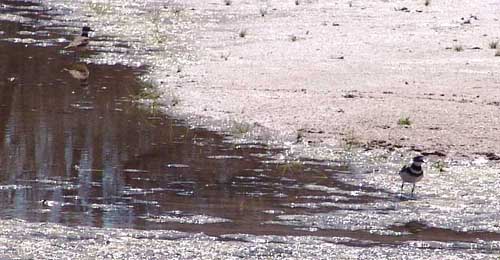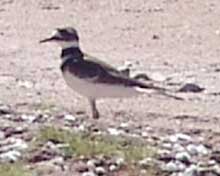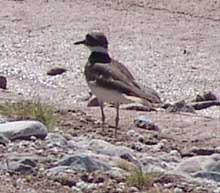Waterbirds
In our Saguaro Juniper lands and portions of the San Pedro River drainage immediately adjacent to them, we find waterbirds only occasionally and where bodies of water are available, which means mainly along the River itself, in places on our uplands where our watertanks are currently holding water, and along the permanent stream of upper Hot Springs Canyon. These are all migratory birds.
Great Blue Heron (Ardea herodias) 
We usually see the magnificent Great Blue Heron streamside in Upper Hot Springs Canyon where it can find numerous small fish to eat, or along the River. Our largest heron, it is generally solitary and nocturnal.
Solitary Sandpiper (Tringa solitaria) 
We rarely see Solitary Sandpipers, members of the genus Tringa (long-legged waders). This one surprised us (along with Killdeer and a flock of ducks) looking for food at the edge of the catchment basin at the Red Tank during one of its most lake-like times, September of 1999. These birds pass through our area in Spring and Fall enroute to and from breeding grounds in Canada and Alaska. (Click on each image below to enlarge it.) The distinctive white eye ring of this species is visible in the closeups, but (due to the poor resolution of the video camera then in use) not the small white dots along the dark back (which also distinguish the Solitary).
 .
. .
. .
.
Killdeer (Charadrius vociferus) 
These two Killdeer, above, were sighted in March 2007 walking along muddy strand on the San Pedro River at its Three-links upstream end (where the water is perennial), but as a species of Upland Plovers Killdeer may often be encountered at considerable distances from water as well. Below, four closer views. (Click on each image to enlarge it.) Three of the four images show the double dark breastband that distinguishes this bird, and also its very long tail.




Killdeer hunt by sight with a run-and-pause technique, eating mainly insects and other invertebrates.
Ducks (species uncertain)
Ducks stop along the River during their migratory seasons, and may visit all of our watertanks when water is present. In November of 2000 these ducks were enjoying the waters of our small Trail Tank.
(Click on each image below to enlarge it.)




American Avocet (Recurvirostra americana)

This shorebird typically forages in muddy waters, sweeping its distinctively recurved and very thin bill from side to side to feed. Nancy Ferguson encountered this flock on September 28, 2013, congregated in the ephemeral muddy pond left behind some months previous by clay-seeking roadworkers near milepost 15 on the Cascabel Road. This species summers in western states from northern Arizona into southern Canada, migrating southward through routes including our San Pedro River Valley to winter quarters in various parts of Mexico.
This flock displays the winter non-breeding colors of both sexes. (From March to August, adult males show an orange head and neck.) Below, this closer view of one bird gives a sense of the bill shape (always black in color).

Upturned curvature in the bill is stronger in females than in males; this bird is probably a male. The black-white stripes pattern on the back is distinctive for this species.
Return to Birds
